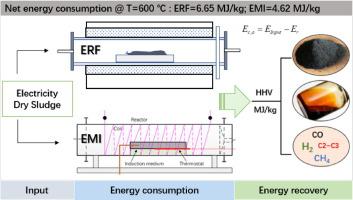Waste Management ( IF 7.1 ) Pub Date : 2020-10-29 , DOI: 10.1016/j.wasman.2020.10.015 Yongjie Xue , Yi Zhou , Jian Liu , Yue Xiao , Teng Wang

|
A comparative study was conducted on the pyrolysis of sewage sludge in tube reactors heated by electromagnetic induction (EMI) and conventional electrical resistance furnace (ERF). A minimal effect of pyrolysis temperature and initial moisture content on the distribution of pyrolytic products was obtained. Compared with the counterpart from ERF pyrolysis, the bio-char from EMI pyrolysis exhibited less ash content (46.38 wt%) and higher organic matter content (53.62 wt%). SEM and FTIR test showed similar microstructure characterizations in the two bio-chars. The specific area of bio-char from EMI pyrolysis was 8.6 m2/g. EMI pyrolysis increased the total content of aliphatic/aromatics in the bio-oil from 10.8 wt% to 15.6 wt% and the hydrogen/carbon monoxide in the bio-gas from 33.8 vol% to 41.1 vol% because of possible cracking and reforming reactions. Increased sulfur content in the bio-oil and decreased hazard gas content (such as hydrogen sulfide and sulfur dioxide) in the bio-gas were obtained during EMI pyrolysis. The actual energy consumption for EMI and ERF pyrolysis were 4.62 MJ/kg and 6.65 MJ/kg. Increasing the feedstock content would reduce the energy consumption unit energy consumption. Less system energy loss during EMI pyrolysis might explain the higher energy recovery from EMI pyrolysis than that from ERF. Despite some disadvantages, EMI pyrolysis shows potential in real-plant applications.
中文翻译:

电磁感应电阻炉加热管式反应器中污水污泥热解的对比分析
对通过电磁感应(EMI)和常规电阻炉(ERF)加热的管式反应器中污水污泥的热解进行了比较研究。获得了最小的热解温度和初始水分含量对热解产物分布的影响。与ERF热解法相比,EMI热解法产生的生物炭具有较低的灰分含量(46.38 wt%)和较高的有机质含量(53.62 wt%)。SEM和FTIR测试表明两种生物炭具有相似的微观结构特征。EMI热解产生的生物炭比表面积为8.6 m 2/G。由于可能的裂解和重整反应,EMI热解使生物油中脂肪族/芳香族化合物的总含量从10.8 wt%增加到15.6 wt%,生物气中的氢/一氧化碳从33.8 vol%增加到41.1 vol%。在EMI热解过程中,生物油中的硫含量增加,生物气中的有害气体含量降低(例如硫化氢和二氧化硫)。EMI和ERF热解的实际能耗为4.62 MJ / kg和6.65 MJ / kg。增加原料含量将降低能耗单位能耗。EMI热解过程中系统能量损失较少,这可能是EMI热解过程中的能量回收率高于ERF的原因。尽管有一些缺点,但EMI热解技术在实际工厂中仍显示出潜力。











































 京公网安备 11010802027423号
京公网安备 11010802027423号